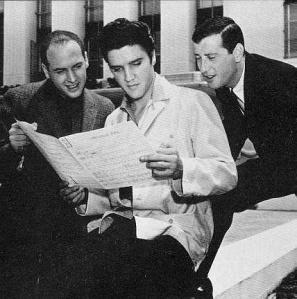By Joel Francis
The Daily Record
The Big Apple has “New York, New York,” “Empire State of Mind” and dozens more. The Windy City has “Sweet Home Chicago” and “Jesus Just Left Chicago.” Tom Waits gifted the Twin Cities with not one but two songs (“Christmas Card from a Hooker in Minneapolis” and “9th and Hennipen”). Visitors to the Bay City are encouraged to “wear some flowers in (their) hair” while the City of Angels gets “California Love,” “Beverly Hills” and “Hollywood Swingin’.” Heck, the even the Gateway City has “St. Louis Blues.”
But there’s only one universally known song about my hometown: “Kansas City.” (Only obsessive music fans and listeners of a certain age will recall “Everything Is Up To Date in Kansas City” and “Train to Kansas City.”) When listening to Jay-Z, Frank Sinatra, Tom Waits and Louis Armstrong boast about other American cities I try to find comfort reminding myself that the Beatles only sang about one city during their career and they chose “Kansas City.”

“Kansas City” is the only song visiting performers feel obliged to work into their setlist. Willie Nelson played it at Farm Aid earlier this month and Paul McCartney used it to open his 1993 show at Arrowhead Stadium (the recording from that night also appears the album “Paul Is Live”). I’ve heard the song so many times in concert I feel like someone should tell all touring acts that no, really, they don’t have to play “Kansas City” on our behalf.
It’s not like the song is invisible around town. Twelfth Street and Vine may be gone (typical of my hometown – undermining its greatest assets), but the song is still very present. Go to a Royals game and if you stick around until the end you are guaranteed to hear “Kansas City.” If the boys in blue win, fans are treated to the Beatles version. If they lose then Wilbert Harrison is piped through the speakers.
“Kansas City” was seven years old by the time Harrison got his hands on it. Originally recorded by bluesman Little Willie Littlefield in 1952, the song was written by a couple of 19-year-old Jews inspired by a Big Joe Turner record. Littlefield’s performance featured a somewhat racier chorus, ending with the line “with my Kansas City baby and some Kansas City wine.” When Federal Records received Littlefield’s recording they promptly rechristened it “K.C. Lovin’.”

Harrison had been performing “K.C. Lovin’” for years before he decided to record it in 1959 under its original title and with the sanitized chorus we all know today. Released on Fury Records, the platter went straight to No. 1 and spawned an army of imitators. Within weeks, interpretations of “Kansas City” by Hank Ballard, Rockin’ Ronald, Little Richard, Rocky Olson and a reissue of Littlefield’s original recording could be found in record shops. Paired with his own “Hey Hey Hey,” Little Richard’s cover hit No. 27 in the UK and inspired the Beatles’ recording.
The men – boys, really – who penned “Kansas City” wouldn’t visit the town that inspired their song until the mid-‘80s, nearly 35 years after handing the tune to Littlefield. Despite this handicap, Jerry Leiber and Mike Stoller nailed their vision of “a melody that sounded like it could have come out of a little band in Kansas City,” as Stoller later explained on a UK television show.
Hot on the heels of “Hound Dog,” “Kansas City” cemented Leiber and Stoller’s reputation as rock and roll’s hottest songwriters. Before the decade was out they would write scores of hit songs for the biggest singers of the day – Elvis Presley, the Drifters, Phil Spector, Ben E. King and, especially, the Coasters – and shape the young days of rock and roll more than anyone else. A sampling of their songs from the time reads like an early rock and roll greatest hits collection: “Hound Dog,” “Jailhouse Rock,” “Smokey Joe’s Café,” “Riot in Cell Block Nine,” “On Broadway,” “Love Potion No. 9,” “Young Blood,” “Searchin’,” “Yakety Yak,” “Stand By Me” and on and on.

The duo’s use of strings on the Drifters’ “There Goes My Baby” predates (and foreshadows) the Motown sound that would dominate pop music in the coming decade. In fact many of their arrangements and innovations were so prescient that Leiber and Stoller found themselves on the sidelines for much of the 1960s. The Beatles and other British Invasion bands learned to write emulating Leiber and Stoller and other Brill Building songwriters, making third-party songwriters largely redundant. The expansive use of the recording studio rendered Leiber and Stoller’s pioneering arrangements sounding (for a while) like quaint relics of the past.
Despite these advancements, rock and roll and pop music will never outgrow the shadow of Leiber and Stoller. Grammy awards, hall of fame inductions and songwriting royalties stand as a testament to Leiber and Stoller’s perpetual influence. Even “American Idol” paused to pay tribute with an all Leiber-and-Stoller episode last spring.
Jerry Leiber, 78, died Monday. His survivors include Mike Stoller, his songwriting partner of 60 years, his family and everyone who ever picked up the guitar or sat down at the piano and tried to write a song or become a star.
Keep reading:
Solomon Burke’s Sweet Soul Music

